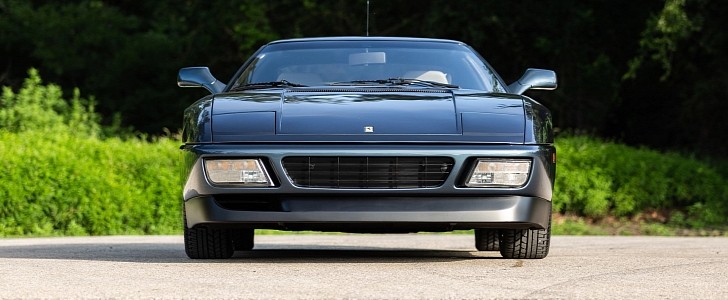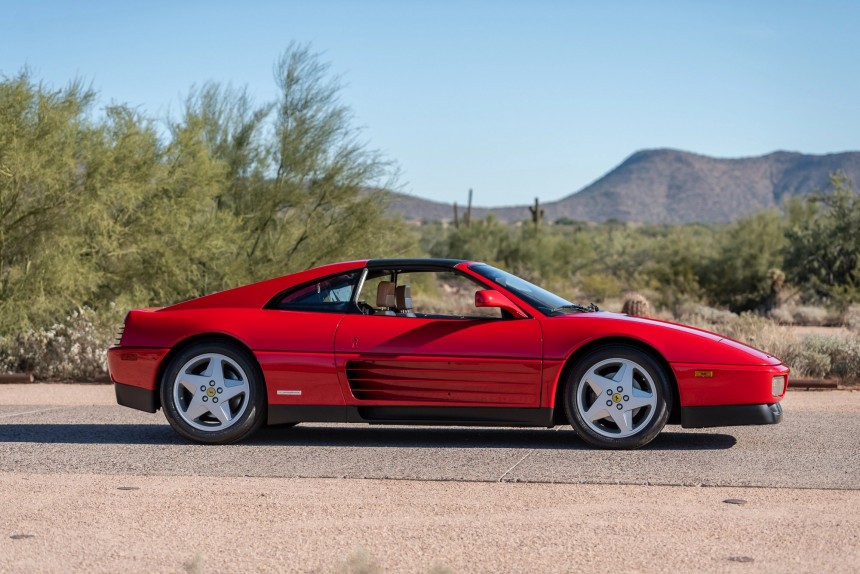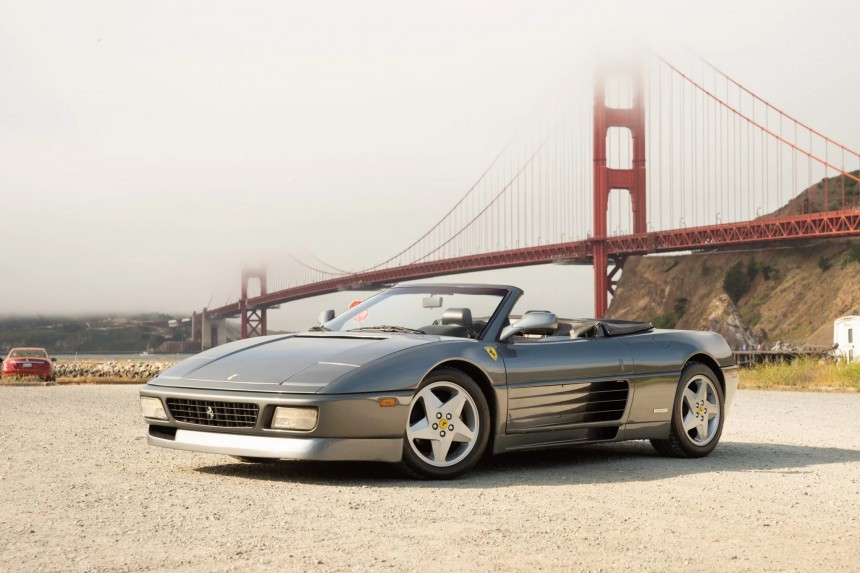Commissioned for production after Enzo’s death, the Ferrari 348 was presented in September 1989 at the Frankfurt Motor Show as a clean-sheet design. Unlike the tubular chassis of the 328 and every other mid-engine model before it, the Pininfarina-styled 348 is a monocoque.
Similar to its forerunner, the mid-engined V8 sports car was offered in two body styles: tb for Trasversale Berlinetta, and ts for Trasversale Spider. Come 1993 when the canvas-topped Spider was introduced into production as part of the mid-cycle refresh, the targa-topped ts was renamed GTS and the tb was renamed GTB. The first series-production convertible since the alluring Daytona Spider, the 348 Spider features a manually folding top.
Gifted with unitary construction to meet ever-stringent crash regulations, the 348 is longer in wheelbase than its predecessor. That shouldn’t come as a surprise given the automotive industry’s trends. In this case, the Prancing Horse of Maranello didn’t really have a choice because of the longitudinal engine. Except for the Mondial t, F40, and 288 GTO, all of the previous midships came with transversally-mounted powerplants.
Connected to a transverse five-speed manual transmission, the 3.4-liter V8 in the 348 can trace its roots back to the 2.0- and 2.4-liter Dino V6 mills from the 1960s, which were developed into the 2.9-liter Dino V8 in 1973. Mounted on a subframe together with the stick shift, this lump is constructed from light alloy for both the block and heads. Cylinder liners coated in Nikasil, four valves per cylinder, a 90-degree angle between the banks, dry-sump lubrication, and Bosch management also need to be highlighted.
Designated F119, just like the afterburning turbofan developed by Pratt & Whitney for the Lockheed Martin F-22 Raptor, the free-breathing powertrain runs a 10.4:1 compression ratio. 220 cubic centimeters larger than the 3.2-liter V8 in the 328, the 3.4-liter V8 in the 348 originally produced 296 horsepower and 238 pound-feet (323 Nm) at 4,200 rpm.
Tipping the scales at 1,393 kilograms (3,071 pounds) for the tb and 1,398 kilograms (3,082 pounds) for the ts, the 348 needs less than six seconds to reach 100 kilometers per hour (62 miles per hour). Both body styles are much obliged to reach 275 kilometers per hour (171 mph) on full song.
Equipped with double-wishbone independent suspension backed up by trick dampers from Bilstein and a pair of anti-roll bars, the 348 came standard with anti-lock brakes and 17-inch wheels that measures 7.5 inches in width at the front and 9 inches out back. A limited-slip diff was also standard issue, along with heated power mirrors, electric windows, and air con.
Fitted with a 95-liter fuel tank, which is 25 gallons in the United States, the 348 boasts high-quality leather upholstery on the seats, center console, lower dashboard, door cards, and transmission tunnel. Customary of a Ferrari, the five-speed tranny is augmented by a beautiful gated shifter.
Optional extras weren’t many. Customers were offered fitted luggage from Modena-based Schedoni and metallic paintwork, and that’s about it. For the U.S. and a few other markets, Ferrari equipped the 348 with catalytic converters. The U.S. also received an evaporative emissions control system, and taken together, this componentry added 85 kilograms (187 pounds).
The company further upgraded the 348 to a Nippon Denso starter motor and a single-plate clutch in 1991. Next year, the 12-volt battery was relocated to the front of the vehicle. Production of the tb and ts came to a halt in 1993 when Ferrari introduced the revised lineup. 7,125 units were produced.
Presented on Rodeo Drive in Beverly Hills, the 348 Spider previewed what was in the offing for the 348 GTB and 348 GTS. The 3.4-liter V8 in the open-top sports car had its compression ratio upped, a new exhaust system, timing belts, valve springs, and a larger intake plenum. That’s how Ferrari extracted 316 horsepower, albeit U.S. models were downtuned to 312 hp.
Improved with a taller fifth gear for better fuel economy and a twin-plate clutch, the Spider was reinforced in various areas to recover the torsional rigidity lost from hacking the roof off. The GTB and GTS were presented later that year at the Frankfurt Motor Show with a top speed of 280 kilometers per hour (174 miles per hour) and a slightly lower curb weight.
Ferrari quoted 1,370 kilograms (3,020 pounds) for all three variants, and as a result of more power and less weight, the acceleration to 100 kph (62 mph) was improved by a tenth of a second. As ever, the 348 came with a 10,000-rpm tachometer even though the 3.4-liter engine could not rev that high.
Discontinued in the spring of 1994 in favor of the F355, the 348 GTB and 348 GTS totaled 440 examples. The 348 Spider kept on keeping on until 1995, and all told, the Prancing Horse delivered 1,090 units worldwide.
Gifted with unitary construction to meet ever-stringent crash regulations, the 348 is longer in wheelbase than its predecessor. That shouldn’t come as a surprise given the automotive industry’s trends. In this case, the Prancing Horse of Maranello didn’t really have a choice because of the longitudinal engine. Except for the Mondial t, F40, and 288 GTO, all of the previous midships came with transversally-mounted powerplants.
Connected to a transverse five-speed manual transmission, the 3.4-liter V8 in the 348 can trace its roots back to the 2.0- and 2.4-liter Dino V6 mills from the 1960s, which were developed into the 2.9-liter Dino V8 in 1973. Mounted on a subframe together with the stick shift, this lump is constructed from light alloy for both the block and heads. Cylinder liners coated in Nikasil, four valves per cylinder, a 90-degree angle between the banks, dry-sump lubrication, and Bosch management also need to be highlighted.
Designated F119, just like the afterburning turbofan developed by Pratt & Whitney for the Lockheed Martin F-22 Raptor, the free-breathing powertrain runs a 10.4:1 compression ratio. 220 cubic centimeters larger than the 3.2-liter V8 in the 328, the 3.4-liter V8 in the 348 originally produced 296 horsepower and 238 pound-feet (323 Nm) at 4,200 rpm.
Equipped with double-wishbone independent suspension backed up by trick dampers from Bilstein and a pair of anti-roll bars, the 348 came standard with anti-lock brakes and 17-inch wheels that measures 7.5 inches in width at the front and 9 inches out back. A limited-slip diff was also standard issue, along with heated power mirrors, electric windows, and air con.
Fitted with a 95-liter fuel tank, which is 25 gallons in the United States, the 348 boasts high-quality leather upholstery on the seats, center console, lower dashboard, door cards, and transmission tunnel. Customary of a Ferrari, the five-speed tranny is augmented by a beautiful gated shifter.
Optional extras weren’t many. Customers were offered fitted luggage from Modena-based Schedoni and metallic paintwork, and that’s about it. For the U.S. and a few other markets, Ferrari equipped the 348 with catalytic converters. The U.S. also received an evaporative emissions control system, and taken together, this componentry added 85 kilograms (187 pounds).
The company further upgraded the 348 to a Nippon Denso starter motor and a single-plate clutch in 1991. Next year, the 12-volt battery was relocated to the front of the vehicle. Production of the tb and ts came to a halt in 1993 when Ferrari introduced the revised lineup. 7,125 units were produced.
Improved with a taller fifth gear for better fuel economy and a twin-plate clutch, the Spider was reinforced in various areas to recover the torsional rigidity lost from hacking the roof off. The GTB and GTS were presented later that year at the Frankfurt Motor Show with a top speed of 280 kilometers per hour (174 miles per hour) and a slightly lower curb weight.
Ferrari quoted 1,370 kilograms (3,020 pounds) for all three variants, and as a result of more power and less weight, the acceleration to 100 kph (62 mph) was improved by a tenth of a second. As ever, the 348 came with a 10,000-rpm tachometer even though the 3.4-liter engine could not rev that high.
Discontinued in the spring of 1994 in favor of the F355, the 348 GTB and 348 GTS totaled 440 examples. The 348 Spider kept on keeping on until 1995, and all told, the Prancing Horse delivered 1,090 units worldwide.







































































